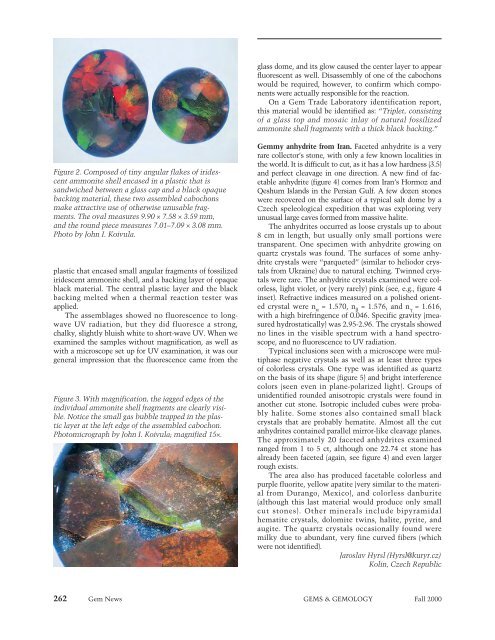Fall 2000 Gems & Gemology - Gemfrance
Fall 2000 Gems & Gemology - Gemfrance
Fall 2000 Gems & Gemology - Gemfrance
You also want an ePaper? Increase the reach of your titles
YUMPU automatically turns print PDFs into web optimized ePapers that Google loves.
Figure 2. Composed of tiny angular flakes of iridescent<br />
ammonite shell encased in a plastic that is<br />
sandwiched between a glass cap and a black opaque<br />
backing material, these two assembled cabochons<br />
make attractive use of otherwise unusable fragments.<br />
The oval measures 9.90 × 7.58 × 3.59 mm,<br />
and the round piece measures 7.01–7.09 × 3.08 mm.<br />
Photo by John I. Koivula.<br />
plastic that encased small angular fragments of fossilized<br />
iridescent ammonite shell, and a backing layer of opaque<br />
black material. The central plastic layer and the black<br />
backing melted when a thermal reaction tester was<br />
applied.<br />
The assemblages showed no fluorescence to longwave<br />
UV radiation, but they did fluoresce a strong,<br />
chalky, slightly bluish white to short-wave UV. When we<br />
examined the samples without magnification, as well as<br />
with a microscope set up for UV examination, it was our<br />
general impression that the fluorescence came from the<br />
Figure 3. With magnification, the jagged edges of the<br />
individual ammonite shell fragments are clearly visible.<br />
Notice the small gas bubble trapped in the plastic<br />
layer at the left edge of the assembled cabochon.<br />
Photomicrograph by John I. Koivula; magnified 15×.<br />
glass dome, and its glow caused the center layer to appear<br />
fluorescent as well. Disassembly of one of the cabochons<br />
would be required, however, to confirm which components<br />
were actually responsible for the reaction.<br />
On a Gem Trade Laboratory identification report,<br />
this material would be identified as: “Triplet, consisting<br />
of a glass top and mosaic inlay of natural fossilized<br />
ammonite shell fragments with a thick black backing.”<br />
Gemmy anhydrite from Iran. Faceted anhydrite is a very<br />
rare collector’s stone, with only a few known localities in<br />
the world. It is difficult to cut, as it has a low hardness (3.5)<br />
and perfect cleavage in one direction. A new find of facetable<br />
anhydrite (figure 4) comes from Iran’s Hormoz and<br />
Qeshum Islands in the Persian Gulf. A few dozen stones<br />
were recovered on the surface of a typical salt dome by a<br />
Czech speleological expedition that was exploring very<br />
unusual large caves formed from massive halite.<br />
The anhydrites occurred as loose crystals up to about<br />
8 cm in length, but usually only small portions were<br />
transparent. One specimen with anhydrite growing on<br />
quartz crystals was found. The surfaces of some anhydrite<br />
crystals were “parqueted” (similar to heliodor crystals<br />
from Ukraine) due to natural etching. Twinned crystals<br />
were rare. The anhydrite crystals examined were colorless,<br />
light violet, or (very rarely) pink (see, e.g., figure 4<br />
inset). Refractive indices measured on a polished oriented<br />
crystal were n a = 1.570, n b = 1.576, and n g = 1.616,<br />
with a high birefringence of 0.046. Specific gravity (measured<br />
hydrostatically) was 2.95-2.96. The crystals showed<br />
no lines in the visible spectrum with a hand spectroscope,<br />
and no fluorescence to UV radiation.<br />
Typical inclusions seen with a microscope were multiphase<br />
negative crystals as well as at least three types<br />
of colorless crystals. One type was identified as quartz<br />
on the basis of its shape (figure 5) and bright interference<br />
colors (seen even in plane-polarized light). Groups of<br />
unidentified rounded anisotropic crystals were found in<br />
another cut stone. Isotropic included cubes were probably<br />
halite. Some stones also contained small black<br />
crystals that are probably hematite. Almost all the cut<br />
anhydrites contained parallel mirror-like cleavage planes.<br />
The approximately 20 faceted anhydrites examined<br />
ranged from 1 to 5 ct, although one 22.74 ct stone has<br />
already been faceted (again, see figure 4) and even larger<br />
rough exists.<br />
The area also has produced facetable colorless and<br />
purple fluorite, yellow apatite (very similar to the material<br />
from Durango, Mexico), and colorless danburite<br />
(although this last material would produce only small<br />
cut stones). Other minerals include bipyramidal<br />
hematite crystals, dolomite twins, halite, pyrite, and<br />
augite. The quartz crystals occasionally found were<br />
milky due to abundant, very fine curved fibers (which<br />
were not identified).<br />
Jaroslav Hyrsl (Hyrsl@kuryr.cz)<br />
Kolin, Czech Republic<br />
262 Gem News GEMS & GEMOLOGY <strong>Fall</strong> <strong>2000</strong>


